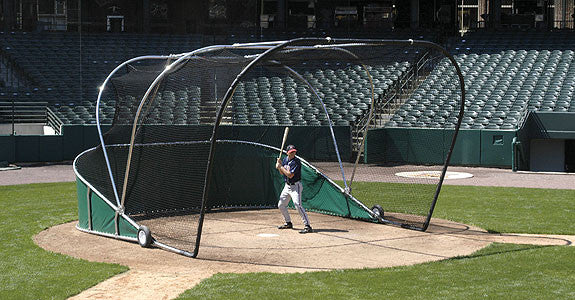Hi Coach,
Coaching up here in Northern California, Little League (10-12 year olds, Majors). The one thing I have the biggest problem with is kids pulling their heads as they swing and not keeping their eyes on the ball. I've tried a lot of home remedies, but nothing works consistently. Any hints?
Thanks,
Don:
=================================================
You are correct this is a problem and you're correct until he can once to stay in and look at the ball while he swings it will not happen.
The first and foremost thing is that they have to get in the right sequence: have to step and get their foot on the ground, rotate their hips,then bring the bat through the strike zone hands first.
The best drill that I've found for this is a version of the soft toss drill. Get a screen (probably a pitcher L-screen) and have the batter stand at the plate (preferably in a cage) and soft toss directly at him both underhand and overhand just like your throwing pitches over the plate, using a screen to protect yourself. This will allow him to concentrate on the three steps and not worry about how hard he's going to hit it or if he's going to get it and he can keep his head down and see the ball all the way and even trying to see it come off the bat.
Hope this helps and if we can help you more with getting DVDs or conversation please just let me know.
Coach Arnald Swift
Baseball tip Some Coaches Notes On Baserunning
I wish I knew why so little time is spent on baserunning in practice.
Maybe there’s just so much to do coaches are less comfortable with their knowledge, and as I said, I don’t know.
But what if it were true that you could actually steal a few extra victories in a season? Would you feel it was important enough to rethink it? I hope, yes. But where would you start...and how would you implement it?
Some quick thoughts:
Decide how much time you would dedicate, then DO IT. Now they can get better, quicker and it becomes a habit for the entire team.,Explain to the team about a new weapon they will be using: baserunning! Let players know that all players can help, not just Johnny Fast-Guy. Be prepared for your 2nd practice drills to go 20-30% better than the 1st! Be prepared to get excited (as will your players) as this happens.
Make it a part of your practice routine. You’ll even come up with more ideas that I PROMISE you’ll “get” as your interest peaks!.
Thoughts on each base:
2nd Base
Second base is called scoring position for a reason.
It takes one hit to score most runners from here...and has the added bonus of eliminating the force or double play and pressures the defense and your opposing coaches further.
3rd Base
There are 9 different ways to score from 3rd base! Can you name them?
Wow! You just have to attack this base and get yourself there. It puts so much pressure on opposing coaches, pitchers, catchers and infielders that you could steal an extra game or three over the course of a season!
Jeannie
thank you for the question would be happy to come in on as I've been faced with this very problem with my two boys and, so the kids that I've coached over the 40 years. This is going to be my coaches/dad answer.
There is no doubt in my mind you play for the team that is not highly ranked in your description. It has zero value for player development, player enjoyment, player advancement to sit on the bench. If you're not playing you're getting behind in a 10% playing time, top team really is nothing is nothing but late inning appearances, games that don't mean anything, games that are already lost or one that he would be getting in.
The only value playing with the team is the social interaction, and the prestige with that similar very thin when you're not getting to do anything to contribute. The one thing I can't see is how good he is and why he's only a 10% player, if there's a reason that he can overcome to become one of the 90% players and that's what he needs to do but he's going to do it by playing6 not sitting on the bench.
Then finally let me say one thing is a coach and a the may sound a little harsh this is 13-year-old baseball there no scholarships, there's no real glory outside of what you give it to yourself, there's going to be at least five more years of trying to become a player. When it really counts is in the high school, or the 17 and up summer teams. But he'll never make those sitting on the bench. He needs to be playing. Now if a boy or girl is a player and they are playing and they should be moving up within their age brackets play the top competition that's available. But they have to be able to play and succeed.
Let me ask you a question when I was coaching basketball in a very small high school I was the JV coach. We had a senior that was not very good in fact he was going to get cut as a player but he was a super kid is a person so we gave him the choice, a rare choice of high school, that as a senior he could play on the JV team and play not to set. He chose to be the 13th man 12 man squad at the high school level instead of to play at the JV level. So in reality he didn't play at all and all the games that season he probably got on the floor maybe a total of five minutes. So my question is was he right or wrong. To me that's the same question you're asking here is better to sit or better to play. It's always better to play in my mind and in my advice.
Coach Arnald Swift
34 years of teaching, 40+ years of umpiring, 40 years of coaching at all levels from youth to D1, coached almost every sport there is one point of the other.
Question from a coach: We have players that are constantly late to practice, one boy in particular. What is the best way to handle it. He is one of your best players. Should we not start him, not play him, punish him by running. What do you think?
Frustrated Coach Schmidt
==============================
Coach this is a constant problem with coaching, and every coach that is actually coached more than one day he has had this problem. The first time you might talk to him and his parents if there are involved but with the ongoing problem there needs to be some kind of discipline. And you have to balance it between penalizing the entire team, being fair getting your point across to the player. So really it probably needs to be a hierarchy of what you're going to do. This first one may be a little late but I found if you make them stay after practice even if it's just for a few minutes telling them you need to make up some work they really don't like that and the parents will take notice also. If you have a young enough team that may work very well as parents get to be nervous that you're eating into their time.(Not to mention your eating into your time by staying after). The second level to just send the player home or exclude him from practice. This works very well with school team player then the next practice have him to physical drills as punishment. What we want to do in all this is not have him quit or harm the team. BUT the last deal is missing playing time or a game.
Explain that he took time from the other players, the coach's, parents all those that are supporting him Now we have to take time from you to impress on you the importance of being there all EVERYONE not just yourself.
Darryl to Coach Arnald Swift
I was holding the radar gun (Striker (sic) STALKER but I don’t know the model number) for my nephew. Being a physicist rather than knowing anything useful about baseball, I noticed it read to one decimal point from which I inferred it was measuring speed to the nearest 0.01 mile per hour and the rounding to the nearest 0.1 mile per hour. I asked him if he knew what the accuracy of the gun was and its precision and he didn’t so my 1st question is what is the accuracy and precision of your guns. My second question is how close to parallel to the balls flight path must the gun be pointed before it begins to reads wrong due to the misalignment and does anyone ever worry about that? I think he is very happy with the gun, I was just wondering about these things so thought I would ask.
==================================================
Darryl
I apologize for not getting back to you with my thoughts and comments on your letter, somewhere other this got send it to spam and I just discovered it today I had no means or way meant to slight you because the question is interesting. I taught math and computers and so I also think a little bit like yourself.
As far as the accuracy of the guns even the most accurate of guns don't actually read in the hundreds of a mile, it's common to see 10th of a mile but when we use the professional guns made by Staker (most popular among professionals) they read in miles per hour not hundredth or tenths from a radar gun on a baseball or any other sports ball.
A radar gun reads in a direct line best so when doing baseball to set up behind the pitcher or behind the catcher in a straight line to get the absolute most accurate reading. Then also remember that the radar field measures about 30 feet away from the location where the ball started or stopped. It's interesting to note that the speed of the ball out of the hand at 30 feet is faster than the ball at the catcher 30 feet away into his glove. Simple physics in a way the ball is actually slowing down on its way to the plate and perception but it is a little bit slower as it reaches the plate. For baseball people the most accurate is at the plate because that's where the batter has to hit it.
Now the angle of reading the flight of the ball is ideally 0 to 10° but you can get relatively accurate readings up to about 20° of variance the good guns have the ability to do some math internally and get an accurate reading from off a direct line. And one other factor that you did mention is how far away there are some smaller versions, cheaper versions, that need to be within about 20 to 30 feet to have any accuracy at all then the professional type guns are accurate through screens, batting cages, that kind of material from up to 300 feet. I've always found it interesting that the manufacturers of police radars, have the same exact radar guns available to the sporting industry. They just change the recording devices to meet the needs.
Hope this helps in your thoughts and your curiosity and I certainly appreciate your interest and sorry about the time lapse.
Coach Arnald Swift BATCO
 Stalker Radar Gun Sport 2
Stalker Radar Gun Sport 2
Coach
My son pitched to one batter in his last game. The bases were loaded when he came in and he unfortunately walked in the winning run. How is this counted against him since none of the runs were his. Is he credited with anything except the walk?
Larry
You are correct, the walk is all your son, pitcher, get placed on his score sheet for that game. The other 3 runner and there actions were the responsibility of the original pitcher. Though I know internally your son feels like it is his fault, but he did not put those 3 runners there, and how would he feel if they scored in some other way EX: pass ball, error, steal those things that he had no control over the result would have been the same and your son (the pitcher) did his job and other did not, that is why it is a team WIN OR LOSS, a single act did not cause this result. Take up an individual sport like, golf, wrestling, tennis, track where you have total control over the situation. He will be fine and I ask you don't worry about statistics, just as the team of which your son is part of to do things right then winning and losing will take care of itself.
Coach Arnald Swift
From Greg
Hi Coach,
Well, it’s been 3 years since I sent this email to you. You said to let you know how things are going. I took your advice and found an academy for my son to attend. It’s a four hour round trip to Springfield, MO to Midwest Baseball Academy. Kyle plays on the USSA 14U majors team. He just turned 14 a week ago. He’s 6’1” 182# and built like a brick school house. They put radar on him in August and he was throwing 87 mph. He carried a .470BA with 18HR.
After summer travel ball we asked the local high school coach if Kyle could practice with the high school team while they played fall ball. Needless to say Kyle was a little intimidated being in eighth grade and playing with juniors and seniors. Before their first game we told him not to be surprised if he didn’t get to play much, if at all. He started the first game at SS and had a fantastic performance. He batted third. His first AB, first pitch, 350’ HR. Second AB first pitch also 350’. He finished 4/5 with triple and single. The high school played 10 games in fall ball. He had 32AB, 8HR, 21 hits, 2 SO. He got to pitch in 5 games, 15 innings, 27 strikeouts.
For my wife and I here’s the best part. Kyle is a straight A student, is loved by all his teachers and class mates. He is a leader in class and sports. We spend so much time on the road together it gives plenty of time for “life’s lessons”. He’s very humble and is not always comfortable with the attention he seems to get from players, coaches, and even umpires.
I know this probably sounds like somebody’s bragging Christmas letter, but I try to listen to people like you when advice and cautions are shared.
Thanks again,
Kyle’s Dad
Greg Fincher
Hello Coach,
My question is what can we do about a hitter that is habitually late with her swing? It doesn"t seem to matter if the pitch is fast or slow!! Her mechanics and bat speed are great! She will be a sophomore at UW Whitewater this year. If she doesn't correct this problem soon, I don't think she will make the team this fall.
Thanks Tom
Tom
You're concerns are well-founded, because if the situation is as you describe no matter what pitch speed or type that she is always behind and misses the ball or hits it to the right side I will almost guarantee that
she's thinking too much.Here's a few things that you might try and ask her to do which by the way she has to do you can't do that for her.
1. While she is standing in the on deck circle she is to review several facts so she's not in her mind before she ever gets into the box-- what did this picture to me last time, what's the situation I'm going to be faced
with outs, runners, defensive position anything that could affect my time at bat she needs to have those answered within her mind before she ever gets into the box.
2. During practice she needs to be told to swing at and hit every pitch no matter what. What this is going to do is take away any thought process and you will be amazed many if not all the pages she puts the bat on.
I've even done this as a coach in a game but I'm going tell you right now her coach is not going to allow it during college game but she might pull it off in practice situations, scrimmages, doing our own.
3. Do this drill against the machine or against a real pitcher and that is what the bat down and watch the ball making a decision whether to swing or not mentally and never really doing anything if she could find the
time and the ability to look at 10 to 15 pitches with no bat it will make a big difference in how she's looking at pitches and in making the decision.
Because in a nutshell that's the problem she's thinking too much and therefore always late and always behind so we need to try to get as much of that out of the way before she gets into the box.
I hope some of this create some thought and even some help and best of luck let me know how it all works out.
Coach Arnald Swift
===========================================
Coach
I coach a 5th grade team and a 7th grade team. My assistant coach on the 7th grade team has instructed the boys to “see the throw” before yelling “cut or no cut”. This really has confused the boys on what they should do. Should we do this at these age levels?
Jeff
I think that is normal for the throw from the outfield. The words and coaching may be a little different but what I believe is he is asking the control guy to do is wait until he see the throw to tell if it is on line, has a chance to make the put out and at what base. The control player can't not say cut, hold, cut to ? until he sees the throw.
So the works "see the throw" is telling him to wait and look at the throw and make the decision of where to go with the throw.
It strikes me as decent point, with different words.
Coach Arnald Swift.










 Stalker Radar Gun Sport 2
Stalker Radar Gun Sport 2